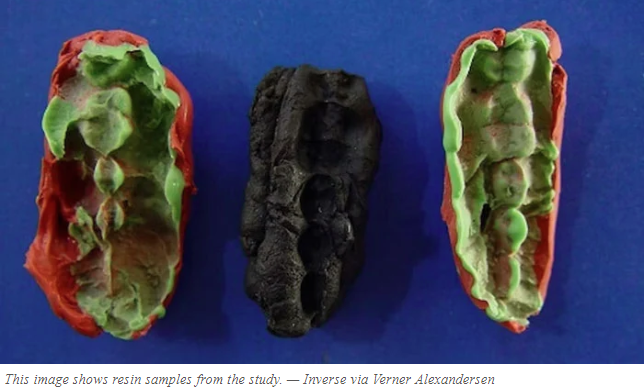Scientist recovered 9,700-Year-Old Chewing Gum. According to a recent breakthrough in archaeological research sheds light on the daily lives of Mesolithic-era hunter-gatherers on the west coast of Scandinavia. DNA analysis of chewed resin from a camping site back 9,700 years reveals intriguing details about their diet, activities, and even a dental predicament faced by one teenager.
Chewing Gum Chronicles:
A group of individuals at Huseby Klev, near Gothenburg, Sweden, engaged in hunting, fishing, and resource collection. The discovery of 1,849 flint artifacts and 115 resin pieces has provided a unique glimpse into their lifestyle just before the advent of European farming.

Teenagers and Chewing Habits:
Teens among this ancient community were found to chew resin made from birch bark pitch. This substance served a dual purpose – as an adhesive in stone tool technology and as a recreational or medicinal chew. However, one teenager faced challenges due to a severe gum infection, hindering the consumption of chewy deer meat and preparation of the resin.
DNA Revelations:
The analyzed resin samples, with imprints of teeth, unveiled not only the dietary habits but also some of the oldest human genomes from Scandinavia. The human DNA showcased a unique ancestry profile prevalent among Mesolithic hunter-gatherers in the region.
Tool-Making Connection:
The presence of both male and female human DNA in the resin suggests that teenagers, despite dental challenges, actively participated in preparing glue for tool making. This adds a fascinating layer to our understanding of the role played by adolescents in ancient societies.
Microbial Insights:
Half of the extracted DNA from the resin is non-human, primarily from bacteria and fungi that thrived in the chewed substance for nearly 9,700 years. The study provides insights into the microbial composition, offering a glimpse into the oral environment of these ancient individuals.
Relevance to Modern Dentistry:
The research not only delves into ancient lifestyles but also draws connections to modern dental issues. By comparing the data to contemporary dental problems like tooth decay and periodontitis, scientists highlight the complexity of dental analysis and the need for advanced computing tools.
This groundbreaking study, published in Scientific Reports, transforms a simple chewing gum into a time capsule, unlocking the mysteries of Mesolithic life in Scandinavia. The combination of DNA analysis, archaeological findings, and insights into ancient dental health contributes to a richer understanding of our shared human history.


Comments are closed, but trackbacks and pingbacks are open.